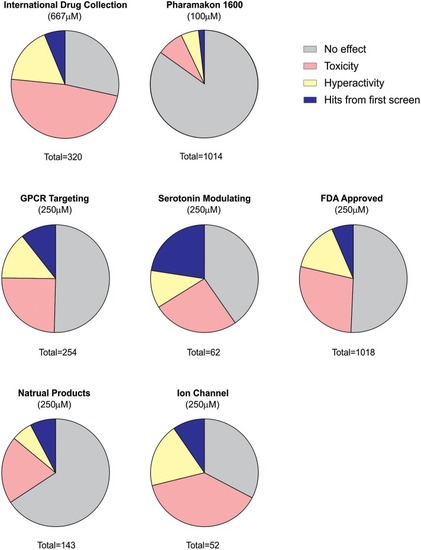
Summary of behavioral screening results for anti-seizure compounds in DS zebrafish larvae. In total, seven commercially available libraries have undergone blind screening for compounds which suppress the seizure activity in scn1labs552 homozygous larvae. These include the MicroSource Discovery Systems' International Drug Collection (Baraban et al., 2013) and Pharmakon Collection (Dinday and Baraban, 2015) and Selleckchem's, ion channel library, GPCR compound library, a serotonin modulating compound library (Griffin et al., 2017), a natural product library and a FDA-approved compound library. Plots represent the results from the first blinded screening of each library. A hit is recognized as a compound which reduces the high-speed seizure like swim behavior by more than 40% (>2 S.D.). Once a hit is retested it is then screened by an independent laboratory member. If identified as a hit again, the compound is unblinded and independently sourced for further testing including the second stage electrophysiology assay. The serotonin library exhibited the greatest percentage of positive hits in the first-pass behavioral assay consistent with subsequent identification of four serotonin modulating drugs for the potential treatment of DS e.g., clemizole, trazodone, lorcaserin and fenfluramine. It is also interesting to note that the percentage of toxic drugs is greatest in the ion channel library cohort. Approximately 20% of compounds are identified as toxic when screened at 250 μM as they result in decreased or absent heart beat and/or an absent touch-evoked escape response after 90 min of exposure. When screening at 667 μM, 48% of compounds were identified as toxic. The majority of compounds fail to elicit any significant change in the swim velocity of the larvae.
|

